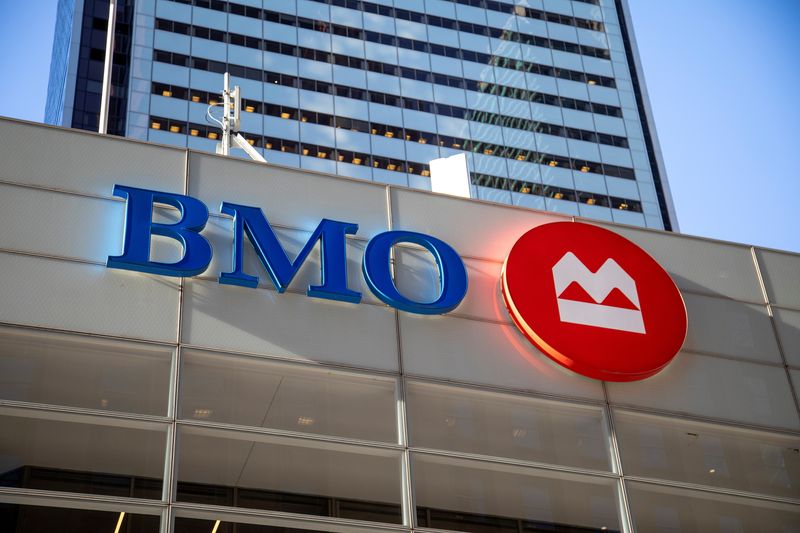BMO, Scotiabank miss profit estimates as bad loan provisions, costs rise
2023.08.29 10:26

© Reuters. FILE PHOTO: A sign for the Bank of Montreal in Toronto, Ontario, Canada December 13, 2021. REUTERS/Carlos Osorio
By Nivedita Balu and Pritam Biswas
(Reuters) – Bank of Montreal and Bank of Nova Scotia, Canada’s third and fourth largest banks, missed analysts’ estimates for quarterly profit on Tuesday as they set aside more funds to cover for bad loans.
The results come as the Bank of Canada’s 10 interest rate hikes since last year have slowed the housing market, increased consumer debt and delayed mortgage repayments, forcing banks to set aside more money to protect against potential loan losses and restraining their earnings growth.
BMO, which bought U.S. regional lender Bank of the West earlier this year, said provision for credit losses rose to C$492 million ($361.42 million), compared with C$136 million a year ago.
The bank’s earnings were also affected by severance costs of C$162 million and C$83 million in legal provisions at its capital markets unit. Chief Financial Officer Tayfun Tuzun said the costs were a one-quarter phenomenon, but would drive expense savings of C$200 million next fiscal year.
BMO’s shares, which have lose about 7% so far this year, were down more than 2% in early trading in Toronto.
At Scotiabank, provision for credit losses jumped to C$819 million from C$412 million.
“We are closely monitoring customer behavior and have observed a very rational and responsible shift in spending as households manage through this period of reduced discretionary income,” Scotiabank CEO Scott Thomson told analysts.
“We are seeing the impact of recessionary conditions, which are reflected in our elevated provisions,” Thomson said, highlighting its international business.
Income declined at home for both banks, leading to a 5% and 12% fall in BMO and Scotia’s Canadian personal and commercial banking segment.
BMO’s U.S unit, however, grew marginally helped by a strong dollar. Income from Scotiabank’s international business, which includes Mexico and other Latin American countries, also declined.
“While higher provisions are a bit troubling, the fact that Scotiabank is building its reserves on performing loans should receive some favor. However, the pressure on the International segment will not go unnoticed by bears,” Barclays analyst John Aiken said.
Analysts were encouraged by an improvement in Scotia’s capital position to 12.7% and improved expense management.
Scotiabank’s shares were up about 1.3% in early trading.
The aggressive hikes have also allowed banks to charge higher rates and boost their net interest income, the difference between what banks earn on loans and pay on deposits.
At Bank of Montreal, net interest income for the quarter rose to C$4.91 billion, compared with C$4.20 billion last year.
“I like where the rates are today, clearly, we are benefiting from higher longer rates. And we are, I think, pretty well positioned to deal with whatever the monetary authorities do in Canada and the U.S. So at an enterprise level,” BMO’s Tuzun said.
At Scotiabank net interest income fell to C$4.58 billion, from $4.68 billion a year ago, largely hurt by lower corporate lending and lower loan fees.
BMO reported adjusted net income of C$2.04 billion, or C$2.78 per share, in the three-months ending July 31, compared with C$2.13 billion, or C$3.09 apiece, a year earlier. Analysts had forecast C$3.13 per share, according to Refinitiv data.
At Scotiabank, net income came in at C$2.23 billion, compared with C$2.61 billion. On a per share basis, the bank earned C$1.73, a cent below analysts’ expectations.
($1 = 1.3609 Canadian dollars)








